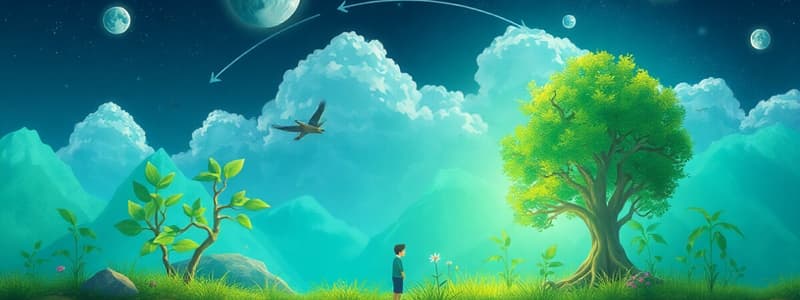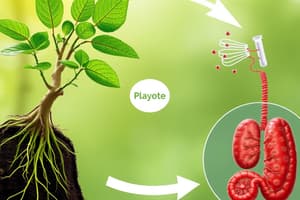Podcast
Questions and Answers
What is the general term for the circulation of matter between the Earth, atmosphere, and living things?
What is the general term for the circulation of matter between the Earth, atmosphere, and living things?
- Respiration
- Biosynthesis
- Combustion
- Cycling of matter (correct)
Which of the following is NOT a key process in the carbon cycle?
Which of the following is NOT a key process in the carbon cycle?
- Respiration
- Nitrogen fixation (correct)
- Photosynthesis
- Combustion
What type of molecules are all carbon-based?
What type of molecules are all carbon-based?
- Lipids
- Proteins
- Carbohydrates
- All of the above (correct)
Which process removes carbon dioxide from the atmosphere?
Which process removes carbon dioxide from the atmosphere?
What is released back into the atmosphere as a result of respiration?
What is released back into the atmosphere as a result of respiration?
The burning of fossil fuels is an example of which process?
The burning of fossil fuels is an example of which process?
What is the largest reservoir of carbon on Earth?
What is the largest reservoir of carbon on Earth?
What percentage of the Earth's atmosphere is made up of nitrogen gas?
What percentage of the Earth's atmosphere is made up of nitrogen gas?
Which process converts atmospheric nitrogen into a usable form for living things?
Which process converts atmospheric nitrogen into a usable form for living things?
What is the name of the process by which nitrogen enters plants?
What is the name of the process by which nitrogen enters plants?
Humans disrupt the nitrogen cycle by:
Humans disrupt the nitrogen cycle by:
What is the term for the disruption that excessive nitrogen causes in aquatic ecosystems?
What is the term for the disruption that excessive nitrogen causes in aquatic ecosystems?
What do plants use from the soil to create biomolecules?
What do plants use from the soil to create biomolecules?
Which of the following is the largest carbon sink?
Which of the following is the largest carbon sink?
In what form do plants use nitrogen?
In what form do plants use nitrogen?
Flashcards
Cycles of Matter
Cycles of Matter
The circulation of matter between the Earth, atmosphere, and living organisms.
Carbon Cycle
Carbon Cycle
The movement of carbon between the Earth, atmosphere, and living things.
Photosynthesis
Photosynthesis
The process where organisms use sunlight to make food from carbon dioxide and water, producing oxygen and glucose.
Respiration
Respiration
Signup and view all the flashcards
Combustion
Combustion
Signup and view all the flashcards
Nitrogen Fixation
Nitrogen Fixation
Signup and view all the flashcards
Assimilation (Nitrogen)
Assimilation (Nitrogen)
Signup and view all the flashcards
Eutrophication
Eutrophication
Signup and view all the flashcards
Carbon Sink
Carbon Sink
Signup and view all the flashcards
Nitrogen Cycle
Nitrogen Cycle
Signup and view all the flashcards
Limestone
Limestone
Signup and view all the flashcards
Ocean Acidification
Ocean Acidification
Signup and view all the flashcards
Deforestation
Deforestation
Signup and view all the flashcards
Carbon
Carbon
Signup and view all the flashcards
Study Notes
- Cycles of matter involve the circulation of matter among Earth, the atmosphere, and living organisms.
- These cycles are crucial for transporting, storing, and making elements like carbon and nitrogen available for biosynthesis.
Carbon Cycle
- This is the movement of carbon between Earth, the atmosphere, and living things.
- Disruption of the carbon cycle by humans contributes to global warming.
- Carbon cycles through photosynthesis, respiration, combustion, and dissolving.
- Photosynthesis uses carbon dioxide, sunlight, and water to produce oxygen and glucose.
- Photosynthesis removes carbon dioxide from the atmosphere, storing it in chemical structures like glucose.
- Carbon moves through the food web as primary consumers eat plants.
- Carbon returns to the atmosphere and soil when organisms die.
- Deforestation reduces carbon dioxide removed via photosynthesis, increasing atmospheric carbon.
- Carbon dioxide is a greenhouse gas; excess amounts in the atmosphere result in global warming and climate change.
- Respiration involves organisms exchanging gases with the environment.
- Cellular respiration uses oxygen and glucose to produce ATP, carbon dioxide, and water.
- Combustion involves burning matter, releasing carbon dioxide into the atmosphere.
- Burning fossil fuels (coal, oil) releases stored carbon into the atmosphere.
- Oceans act as significant carbon reservoirs.
- Carbon dioxide dissolves in water, forming carbonic acid, which can become rock or part of sea animal shells as calcium carbonate.
- Excess carbonic acid in the ocean, due to high carbon dioxide levels, leads to ocean acidification, harming marine ecosystems.
Nitrogen Cycle
- This process moves nitrogen between Earth, the atmosphere, and living organisms.
- Nitrogen is essential for living things, especially in proteins and nucleic acids.
- The atmosphere is 78% nitrogen gas, but this form is unusable for most organisms and must be fixed.
- Nitrogen fixation converts atmospheric nitrogen into usable forms via lightning or special soil bacteria.
- Nitrogen-fixing bacteria convert nitrogen gas to ammonia, which is then transformed into nitrites and nitrates.
- Nitrites and nitrates are forms of nitrogen usable by plants.
- Assimilation allows nitrogen to enter plants and be used to create biomolecules.
- Nitrogen cycles through the food web as plants are consumed.
- Humans disrupt the nitrogen cycle by adding excess nitrogen to ecosystems through fertilizers, causing runoff.
- Excessive nitrogen, a limiting nutrient, can cause eutrophication, disrupting ecosystem balance, especially in aquatic environments.
Comparing Nitrogen and Carbon Cycles
- Element: Carbon and Nitrogen, respectively.
- Carbon cycle steps: Photosynthesis, respiration, combustion, dissolving.
- Nitrogen cycle steps: Fixation, and assimilation.
- Disruption: Increased atmospheric carbon dioxide by deforestation, increased respiration, and fossil fuel combustion which cause climate change; excess nitrogen from fertilizers leads to eutrophication in aquatic ecosystems.
Studying That Suits You
Use AI to generate personalized quizzes and flashcards to suit your learning preferences.




